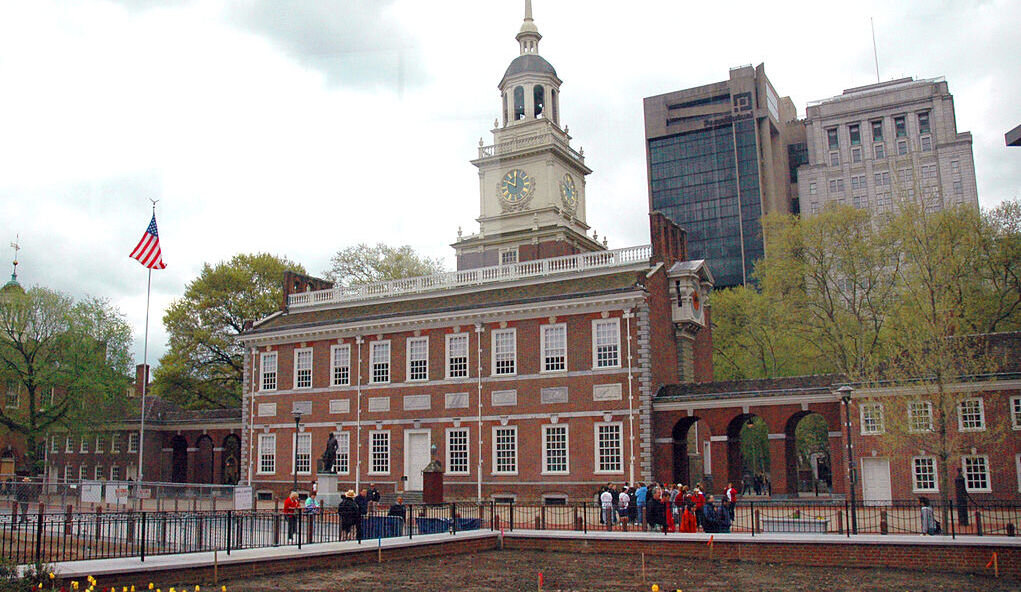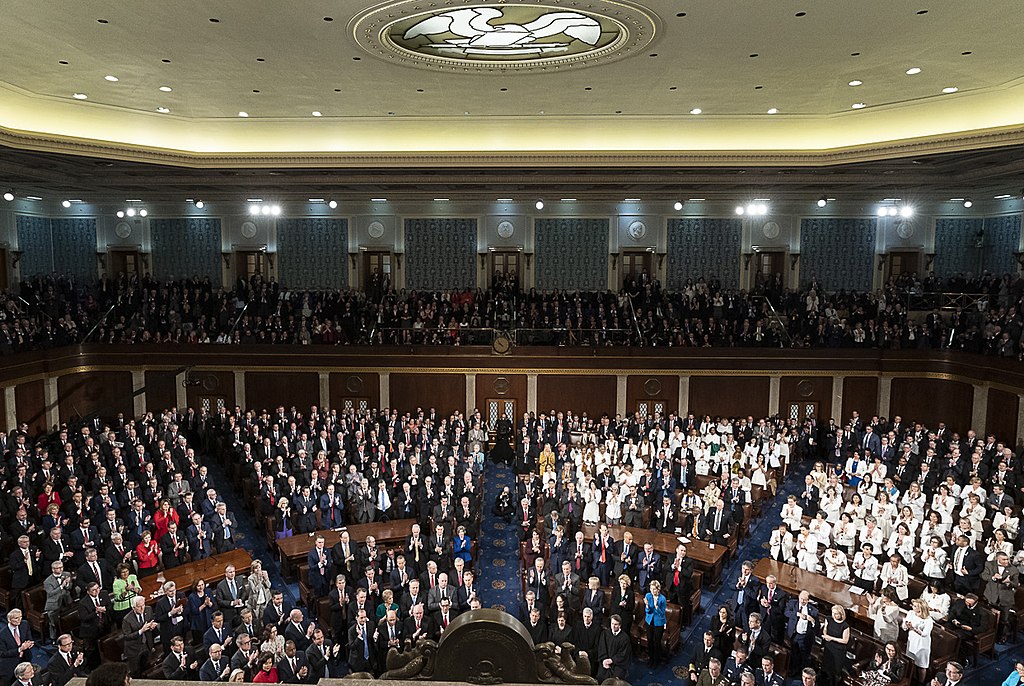Photo credit: JessicaRodriguezRivas (Creative Commons)
Every young person in America is taught in school about the wonders of the U.S. system of government — brilliantly designed to protect freedom, flexible enough to solve any problem, and given legitimacy by the consent of the governed. But this fairy tale version of U.S. politics bears no resemblance to reality.
In fact, these notions might seem so outlandish that many people’s eyes glaze over at the mere mention of the intricacies of how the government functions. But for those who want to put an end to this unjust order, it is absolutely essential to understand those intricacies. It is not necessary to grasp the ins-and-outs of the constitution or the legislative process to come to the conclusion that the system has to end — but to actually bring about this profound transformation of society, we need to know in detail how our enemy operates.
Liberation News is producing the “Civics Class for Radicals” series to shine light on the reality of this system of government of, by and for the rich.
Read Part 1 on the Supreme Court here, and Part 3 on the presidency here
Very few political matters in the United States are as unifying as disdain for Congress. With an approval rating in the low 20s, this institution is widely seen as corrupt, inefficient, and representative of an out-of-touch elite. A major part of this (correct) perception is the convoluted nature of the legislative process, intentionally rife with opportunities for powerful corporate interests to exercise influence. Deciphering how Congress actually works is central to understanding how the ruling class rules.
A congress, in the broadest sense, can be looked at as the original form of ruling class self-organization in the territory that is now the United States. In each of the 13 colonies, there was an assembly that had authority over certain aspects of government. These were composed of the wealthy elites who were voted in by an electorate composed of the white male population of the colony who could prove they owned property. Over time, these became more complex governing structures modeled on the British parliament with two chambers — an assembly, and a “council” of powerful elites who were not elected at all and instead appointed by a governor. The councils were modeled on Britain’s unelected House of Lords, which is made up of members of the hereditary nobility. This became the blueprint for the modern-day U.S. system with a House of Representatives and a Senate — the successor to the ultra-exclusive governor’s councils of the colonial era.
Power struggles between colonial assemblies and the parliament in Britain, especially when it came to the issue of taxation, were a principal cause of the American War of Independence. One of the “Intolerable Acts” passed by the British parliament in 1774 that led to the outbreak of armed hostilities between the British monarchy and its subjects in the now-United States was a law disbanding the Massachusetts colonial assembly.
In response to these laws, a “Continental Congress” was convened with representatives from across the American colonies at the end of 1774, and then again starting in 1775. This second Continental Congress is the body that declared the United States an separate country and directed the war of independence. After the constitution was drafted in 1787, the modern-day Congress came into being. It was composed of two chambers — the Senate and the House of Representatives — that both had to agree for any proposal to become a law.

The Senate
The U.S. Senate is composed of two representatives from each of the states. As such, it is a wildly unrepresentative body that does not take into account differences in population size. A ballot cast by a voter in Montana (population 1.1 million) counts almost 36 times as much as one cast by a voter in California (population 39.2 million).
But for the majority of the Senate’s existence, neither the hypothetical voter in Montana nor in California would have even had the opportunity to participate in such an absurdly undemocratic process. That’s because there were no elections for senators until 1913! Prior to the ratification of the 17th amendment to the constitution that year, each state’s senators were appointed by the state legislature.
A senator serves the longest term of any national office — six years. Every two years, one-third of the Senate (called a “class”) is up for re-election.
The undemocratic character of the Senate is by design. The Federalist Papers — a famous series of articles written by “founding fathers” who supported the new constitution — noted the tendency of “numerous assemblies to yield to the impulse of sudden and violent passions, and to be seduced by factious leaders into intemperate and pernicious resolutions.” Here “numerous assemblies” refers to legislative bodies with a large number of elected members like the newly-created House of Representatives, in contrast to the much smaller Senate. The “intemperate and pernicious resolutions” the founders wanted to avoid were ones that would infringe on the property rights of the elite. In other words, even if the population elected representatives in the House who “yield to the impulse of sudden and violent passions” that threaten the ruling class’ wealth, the Senate would be in place to block its actions.
The Senate also has certain powers that the House of Representatives does not. Perhaps most prominent is its role in the confirmation of cabinet secretaries, judges, ambassadors, and other important officials nominated by the president. Before they can take office, they must receive a vote of support from the Senate. In the event that the president is impeached, the Senate functions as the jury in a trial to determine whether or not the president is in fact removed from office. However, the House of Representatives is the body that can take a simple majority vote to impeach the president — essentially issue an indictment that the Senate then rules on.
The Senate sets its own procedural rules, which can be changed at any point. The most talked about Senate rule in recent years is called the “filibuster.” It holds that debate on a bill cannot be closed unless 60 of the 100 Senators vote to do so. This effectively means that unless 60 senators support the passage of a measure it cannot go forward, because as few as 41 could keep debate open indefinitely and never allow the process to move on to a final vote. Even though it could be eliminated at any time by a simple majority vote, the filibuster is a prized measure to promote ruling-class consensus and elite political harmony, and over the last two years the Democratic Party has consistently prioritized it over implementing its own stated program of progressive reform.
The House of Representatives
Compared to the Senate, the House of Representatives is sometimes thought of as the more democratic of the two chambers. All 435 of its members are elected every 2 years, and represent districts with approximately equal population sizes. But there are still several glaring anti-democratic features of this body.
Perhaps most importantly is a practice called gerrymandering. By manipulating the boundaries of a House district that a politician is running to represent, it is possible to all but guarantee the outcome of an election. The widely-cited Cook Political Report identified 347 seats in the House of Representatives as “solid Democrat” or “solid Republican” — meaning that the district is drawn such that that party is virtually certain to win. That means that the outcome of the election is only ever really in question in one-in-five House districts.
Gerrymandering is one of the principle mechanisms for racist voter disenfranchisement. Black, Latino and other oppressed communities are concentrated in a small number of districts and then evenly dispersed throughout others such that their impact on the outcome of legislative elections is greatly minimized. For instance, in February 2022, the Supreme Court approved a racist scheme by the Republican-dominated state government of Alabama to impose a new Congressional District map that diluted the voting power of Black residents by packing them into a single district. Even though 27 percent of Alabama’s population is Black, only one of the state’s seven congressional seats (14 percent) would elect a Black representative.
Congressional maps are redrawn every 10 years, following each new census. Based on the census results, the total number of representatives a state has can shift along with its population. The right wing, especially during the “redistricting cycles” around the time a census is taken, focuses a tremendous amount of resources on winning control of state-level governments. This enables them to impose racist, rigged maps that subvert democratic rights.
Another deeply undemocratic feature of the House of Representatives is that all seats are determined on a “first past the post” basis. That means that there is a single round of voting where the candidate who has the most votes wins. A common alternative to first past the post used around the world is proportional representation, where people vote for a political party, which receives a number of seats proportional to its vote total if it reaches a specific threshold — oftentimes 3 percent or 5 percent, or even less.
First past the post helps cement the two-party system that is a pillar of political stability for the U.S. capitalist class. It prevents the emergence of third parties that would give voice to left-wing politics and the interests of the working class. For instance, if one candidate receives 40 percent of the vote, another candidate receives 35 percent of the vote, and a newly-formed socialist or labor party won 25 percent of the vote in an election; the left-wing party would receive no representation at all in Congress even though they won the support a quarter of the population in the district. Only in very particular districts would it have a chance of beating both establishment parties, discouraging anyone from even trying for fear of “splitting the vote” and allowing the rightwing to carry the day with minority support. This would not be an issue in a proportional representation electoral system.

How a bill becomes a law — the real version
The legislative process cannot be understood simply as a bureaucratic procedure that takes place within the confines of Congress. It is something that the entire ruling class has the opportunity to take part in, with differences among different elite factions and interests hashed out by their loyal representatives in Washington. The lobbying industry is central to this.
A lobbyist is someone whose profession is to influence the government on behalf of a client, usually a corporation or an association representing a group of corporations in a particular sector. For instance, a lobbyist could work directly for Pfizer, or indirectly represent the collective interests of pharmaceutical industry capitalists through an organization like Pharmaceutical Research and Manufacturers of America, which spent $30.4 million last year alone.
Lobbying is little more than legalized bribery. Lobbyists are often former government officials or even well-known politicians who turn their extensive contacts and connections into a lucrative source of income. While these arrangements may need to be thinly-veiled to avoid running afoul of the law, lobbyists may offer to raise a large amount of money for a politician’s campaign fund, or promise to give lucrative jobs in the future to current politicians and senior staffers — in exchange for policies that benefit their clients. All together, $3.7 billion was spent on lobbying in 2021. Top lobbies include National Association of Realtors ($44 million spent in 2021), the American Hospital Association ($25.1 million), and Facebook parent company Meta ($20 million).
Very frequently, the work of writing a bill happens not in the office of an elected representative, but is done by lobbyists themselves. For instance, this report that appeared on NPR gives an example of this type of direct corporate control of government:
“It’s taken for granted that lobbyists influence legislation. But perhaps less obvious is that they often write the actual bills — even word for word.
“In an example a week and a half ago, the House passed a measure that would roll back a portion of the 2010 financial reforms known as Dodd-Frank …
“The New York Times and Mother Jones obtained draft language that lobbyists for Citigroup — one of the largest banks in the country — offered to lawmakers. And it turns out that 70 of the 85 lines in the final House bill reflected Citigroup’s recommendations. In fact, as The Times reports, two paragraphs were copied almost word for word — except lawmakers had changed two words to make them plural.”
But even if the bill is completely written by corporate lobbyists, a politician still needs to be the one to introduce it into the legislative process. The member of Congress who introduces the bill generally does so with a number of co-sponsors who also attach their name to the proposal from the outset. Lining up a large number of cosponsors is a way to indicate widespread support for a bill.
Then the bill goes to committee. Both the House and the Senate are organized into dozens of committees that are thematically focused. For instance, there is a House Financial Services Committee, a Senate Foreign Relations Committee, and a House Natural Resources Committee. Each committee has a certain number of Democrats and Republicans on it, roughly proportional to how many representatives a party has in that chamber of Congress. Each committee is led by a chair, who sets the schedule and therefore arranges the priorities of the body.
Chairmanships are highly coveted positions, because they come with a huge payday. Take for example Ron Wyden, the chair of the Senate Finance Committee. In his most recent term in office, he received over $1.2 million in campaign contributions from individuals and Political Action Committees associated with the securities and investment industry. A chairmanship can also lead to relationships that can be used for personal enrichment upon leaving office. Jeb Hensarling, a member of the House of Representatives from Texas, chaired the House Financial Services Committee from 2013 until he left Congress in 2019. Three months later, he was given a job at banking giant UBS as their vice chairman for the Americas.
Just like a chair sets the agenda and determines what matters come before a committee, there is an overall leadership of each chamber of Congress that decides what bills come before the entire body for a final vote. The House is led by a Speaker from the majority party, and there is a designated Minority Leader from the other party. The Senate is led by a Majority Leader, with a Minority Leader counterpart. The vice president of the United States is technically the head of the Senate, but effectively only comes into play when they are called on to break a tie vote.
Before a final vote is taken, there is an opportunity for other members of Congress to propose and vote on amendments to the bill. Sometimes, politicians attempt to sabotage a bill they oppose by inserting an amendment into a bill that is contrary to the purpose of the proposal or renders it unworkable. This is called a “poison pill amendment.”
A bill must be passed by both chambers of Congress to become law. If the House and the Senate both pass measures related to the same issue but they are not identical, any differences are resolved through a body called a Conference Committee. Each chamber nominates a number of members to serve on the committee, which exists until a compromise is found that is supported by a majority of the delegation from both the House and the Senate.
The final step is for the president to sign the bill into law. Once the president signs a bill, it comes into force. But if the president opposes a bill that is passed by Congress, they have the option of vetoing it. In the event of a presidential veto, the bill then returns to Congress. If they are able to pass the bill again but with a two-thirds majority, then the presidential veto is overridden and the bill becomes law anyway.
In one sense, Congress is a bureaucratic and complex institution that can deliberate and delay matters of urgent importance for months or years. But at the same time, it is a highly exclusive institution where only elite interests can exercise real influence as this long process plays out. Congress is designed this way to ensure broad buy-in across the ruling class, with every sector of capital given a voice in this democracy of, by and for the rich.






